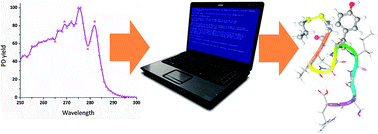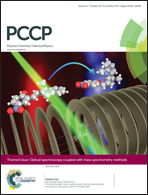Characterizing gaseous peptide structure with action-EET and simulated annealing†
Abstract
Evaluation of biomolecular structure in the gas phase is challenging, but worthwhile due to advantages in sensitivity and speed relative to traditional condensed phase approaches. Herein, we demonstrate that a recently developed method utilizing energy transfer to establish distance constraints can be combined with molecular dynamics calculations to rapidly and accurately reveal gaseous peptide structures. Three peptides in various charge states are examined. The influence of increasing charge state on peptide structure is easily observed. The presence of multiple conformations can be detected. Furthermore, the method is demonstrated to aid the assignment of charge, which is frequently nontrivial for peptides containing numerous acidic and basic residues that could adopt a variety of conformers of equal charge state. Comparison with ion mobility reveals that many low energy structures that are distinguishable by distance constraints would not be resolvable by collision cross section. Action-EET is demonstrated to be a powerful new tool for structure elucidation.

- This article is part of the themed collection: Optical spectroscopy coupled with mass spectrometry methods

 Please wait while we load your content...
Please wait while we load your content...